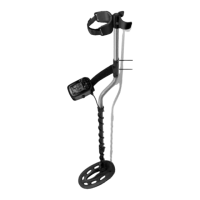19
6
The detector requires a single 9-volt ALKALINE battery
(battery not included).
Do not use ordinary zinc carbon batteries.
Do not use “Heavy Duty” batteries.
Rechargeable batteries can also be used.
If you wish to use rechargeable batteries, we recommend using a
Nickel Metal Hydride rechargeable battery.
The battery compartment is located on the back side of the housing.
Slide the battery door to the side and remove it to expose the battery
compartment.
BATTERY LIFE
Expect 20 to 25 hours of life from a 9-volt alkaline battery.
Rechargeable batteries provide about 8 hours of usage per charge.
SPEAKER VOLUME AND BATTERY CHARGE
You may notice the speaker volume drop while one battery segment is
illuminated.
With one segment flashing, low speaker volume will be very apparent.
BATTERY INDICATOR
The remaining battery life is proportional to the percentage of the battery icon
illuminated.
After the battery indicator begins flashing, expect the detector to shut off within
10 minutes.
BATTERIES
DEPTH AND TARGET DISPLAY
Please refer to the display on your
detector and reference the TARGET-ID
categories below applicable to your
model (not all detectors include all of
these categories).
READING THE DISPLAY
The Liquid Crystal Display (LCD) shows
the PROBABLE identification of the
targeted metal, as well as the PROBABLE
depth of the target.
The detector will register a consistent
target identification, upon each sweep of
the coil, when a buried target has been
located and identified. If, upon repeated
passes over the same spot, the target
identification reads inconsistently, the
target is probably a trash item, or oxidized
metal. With practice, you will learn to
unearth only the repeatable signals.
The segment identifications are highly
accurate, when detecting the objects
described on the label. However, if an
object registers in a given category for an
unknown buried object, you could be
detecting a metallic object other than the
object described on the label, but with the
same metallic signature. Also, the greater
the distance between the target and the
coil, the less accurate the target
identification.
GOLD TARGETS Gold objects will
register toward the middle or left-of-center
on the LCD scale.
Gold flakes will register under iron.
Small gold items will register under foil
or 5¢.
Large gold items will register toward the
center of the scale.
SILVER TARGETS: Silver objects will
register to the right of the scale, under
dime or higher.
IRON: All sizes of iron objects will register
on the far-left side of the scale. This could
indicate a worthless item such as a nail,
or a more valuable historic iron relic.
FOIL:
Aluminum foil, such as a gum
wrapper, will register as foil. A small
broken piece of pull tab may also register
here.
5¢: Most newer pull-tabs from beverage
cans, the type intended to stay attached
to the can, will register here. Many gold
rings will also register here.
ALUM: Older pull tabs, which always
detached completely from the can, register
here. Many medium size gold ring also
register here.
PT (pull-tabs): Pull-tabs from older
beverage cans will register here. Few
newer pull-tabs will also register here.
Many gold rings will also register here.
S-CAP: Older screw caps from glass
bottles will register here. Large gold rings,
like a class ring, could also register here.
Some non-U.S. coins of recent vintage
will also register here.
Zinc: Medium conductivity objects and many
non-U.S. coins of recent vintage are
classified here.
The Target Identification Categories to the
right of the display, such as copper coins,
10¢, DIME, 25¢, Quarter, 50¢, $1
accurately identify these U.S. coins.
When used in areas outside the U.S.,
these categories identify coins or metal
objects of high relative conductivity (such
as silver coins or relics), or large objects
made of any type of metal.
Caution: The target indications are visual
references. Many other types of metal can
fall under any one of these categories.
While the detector will eliminate or
indicate the presence of most common
trash items, it is impossible to accurately
classify ALL buried objects.

